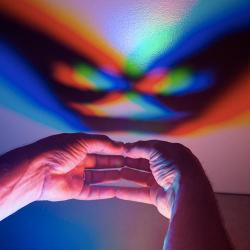Source Institutions
Source Institutions
Add to list Go to activity
Activity link broken? See if it's at the internet archive

In this optics activity, learners discover that not all shadows are black. Learners explore human color perception by using colored lights to make additive color mixtures. With three colored lights, learners can make shadows of seven different colors. They can also explore how to make shadows of individual colors, including black. Use this activity demonstrate how receptors in the retina of the eye work to see color.
- 10 to 30 minutes
- 5 to 10 minutes
- $5 - $10 per group of students
- Ages 6 - 18
- Activity, Demonstration, Exhibit
- English
Quick Guide
Materials List (per group of students)
- White surface. (A white wall, white posterboard, or white paper taped to stiff cardboard works well. Do not use a beaded or metal slide projection screen.)
- Red, green, and blue lightbulbs or floodlamps, one of each color. Sylvania #11 colored lightbulbs or General Electric Dichrocolor Dichroic Floodlamps (150 watt) work well. We have even obtained excellent results with clear-colored Christmas tree lights. Smaller or dimmer bulbs are fine for tabletop use by a few students, but larger, brighter bulbs allow a larger-scale demonstration.
- 3 light sockets of any type or arrangement that will get the light from the three bulbs simultaneously directed onto the same area of a white surface.
- Any solid object such as a pencil, ruler, correction fluid bottle, finger, etc.
- Adult help
Subjects
-
Life Sciences
-
Human Body
- The Brain and Nervous System
-
Human Senses and Perception
- Vision
- Perception
-
Human Body
-
Physical Sciences
-
Vibration and Waves
- Light and Optics
-
Light and Optics
- Electromagnetic Spectrum
-
Vibration and Waves
-
The Nature of Science
-
The Scientific Process
- Conducting Investigations
-
The Scientific Process
Audience
To use this activity, learners need to:
- see
- see color
Learning styles supported:
- Involves hands-on or lab activities
Other
This resource is part of:
Access Rights:
- Free access
By:
Rights:
- All rights reserved, The Exploratorium,
Funding Sources:
- National Science Foundation
- California Department of Education
- NEC Foundation of America
